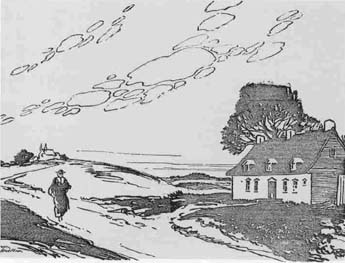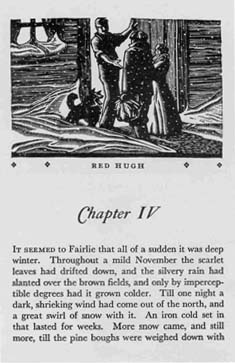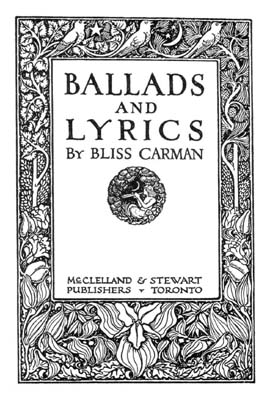
Bulletin 7 (IV:1), 1966
Home
Français
Introduction
History
Annual Index
Author &
Subject
Credits
Contact



Book
Illustration and Design By Canadian Artists 1890-1940 with a
list of books illustrated by
members of the Group of Seven
by Sybille Pantazzi, Librarian,
The Art Gallery of Toronto
Pages 1 |
2 | 3
| 4
Indeed some of the books issued during this decade by
McClelland & Stewart and by the Ryerson Press contain the most
original contribution of the Group of Seven to Canadian book design,
their end-papers. Decorative end-papers became fashionable in the
1890's when Walter Crane, Lucien Pissarro and F. Lewis Day, among
others, designed some delightful ones with delicate repeating
patterns. Pictorial designs were used from the first decade of this
century, those by Edmond Dulac and Maxwell Parrish for children's
books being particularly successful. In the 1920's the use of
decorative maps for end-papers, such as those designed by Rockwell
Kent, became popular, and similar end-papers were designed for
Canadian books in the 1920's and 1930's by J. E. H. MacDonald,
Thoreau MacDonald and Stanley Turner. But the use of the rectangle
of the two facing halves of the end-papers for a bold stylized
sketch in vivid colours was a brilliant and original idea of the
Group of Seven. (14) The most striking end-papers are those by Lawren
Harris (Fig. 11) and Varley (Figs. 12 & 13); those by A. Y.
Jackson (Fig. 14) and Franz Johnston (Fig. 16) are both effective
and typical of their respective styles, while J. E. H. MacDonald's
rhythmic patterns show that he developed a decorative style for book
design quite distinct from his style as a painter (Fig. 15). Bertram
Brooker also, at the end of the 1920's, used with dramatic effect a
geometric design of mountain peaks for the end-papers of the Yearbook
of the Arts in Canada (15) (Fig.17).
Further contributions of the Group to book illustration which are a
delight to re-discover are: A. Y. Jackson's humorous and
affectionate drawings of birds for A Little Book of Bird Songs (1912)
(Fig. 18), or Lismer's witty and apt sketches for The Privacity
Agent (1927) (Fig. 19), or Holgate's wood-cuts for Other
Days, Other Ways, which reveal an unusual talent to evoke the
feel of the Quebec landscape within the compass of small head - and
tail-pieces (Fig. 20), and finally, Franklin Carmichael's vigorous
wood-engravings for Thorn-Apple Tree (1942) (Fig. 21).
Thoreau MacDonald's work as a designer and illustrator of books is
too well known (16) to need any comment here, but his charming
designs for A Canadian Child's ABC (Toronto, Dent, 1931)
(Fig. 6) have not yet received their full due of appreciation. His
alphabet of Canadian animals and scenes contains in microcosm all
the precision and rustic poetry which is characteristic of his best
work, and on a scale admirably conceived to appeal to children.
Two isolated figures in the 1930's were Bertram Brooker and J. W. G.
Macdonald. The former, self-taught, may be said to be the most
ambitious of the Canadian illustrators so far, for he was alone to
tackle the great classics: Elijah (New York, William Edwin
Rudge, 1930), The Ancient Mariner and Crime and Punishment. Unfortunately the latter two were never
published. (17) As original in his illustrations as in the rest of
his work, J. W. G. Macdonald provided some striking designs for The
Neighing North (Toronto, Ryerson Press, 1931), a book of poems
by A. C. Dalton. One of his frosty and spirited drawings for that
book is reproduced (Fig. 22).
An attractive example of the work of Stanley Turner, who was also a
fine illuminator, can be seen in The First Canadian Christmas
Carol (Toronto, Rous & Mann, 1927) (Fig. 23). Turner's style
in these illustrations shows more affinity with the international
style of the 1920's (the illustrations of Albert Rutherston in
England or of Carlègle in France, for example) than does the work
of the other artists mentioned here.
Robert La Palme is appreciated for his clever caricatures and
posters, (18) but his illustrations for Ristontac (by Andrée
Maillet, Montreal, Lucien Parizeau, 1945) (Fig. 24) deserve to be
better known. The happy combination of flat, stylized pictures in
gay primary colours and fluent calligraphy places his book with the
best of the Père Castor series published in France by Flammarion in
the 1930's.
In conclusion, I should like to emphasize that this survey is only
an introduction to the subject. Hence a number of interesting books
and illustrators of the period have not been mentioned, and no
attempt has been made to deal with illustrations in periodicals. My
main purpose has been to show the important role played by the
Toronto Art Students' League and by the Group of Seven in the
development of book illustration and design in Canada. But a great
deal remains to be discovered and studied. (19)
Next Page | Notes
1 |
2 | 3
| 4
Annual Index | Author & Subject | Credits | Contact
This digital collection
was produced under contract to Canada's Digital Collections program,
Industry Canada.
"Digital
Collections Program, Copyright
© National Gallery of
Canada 2001"